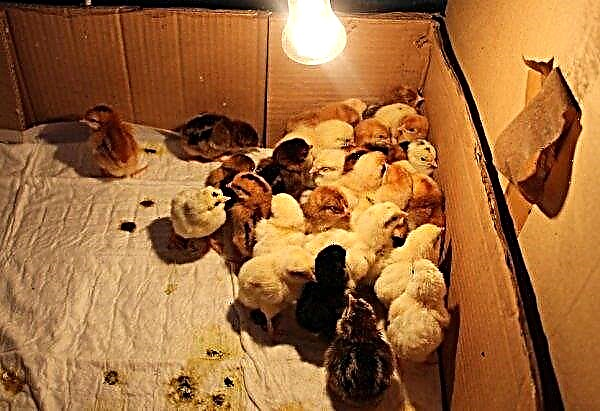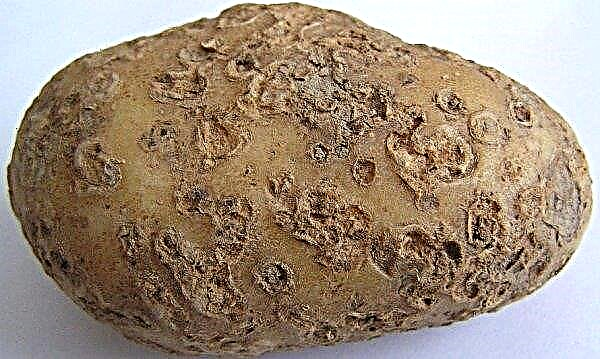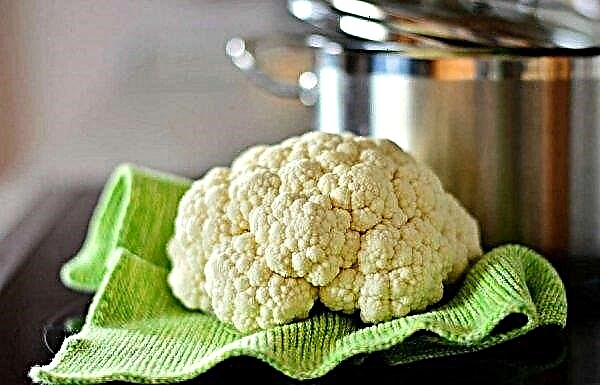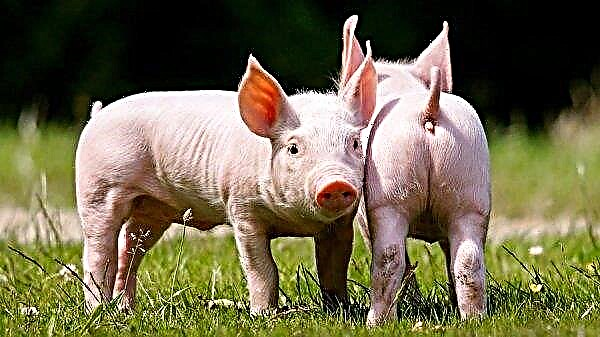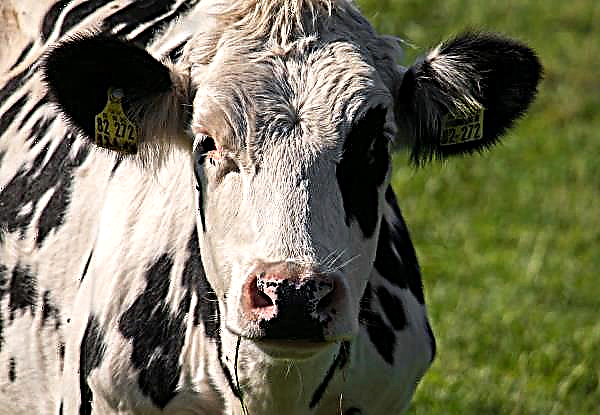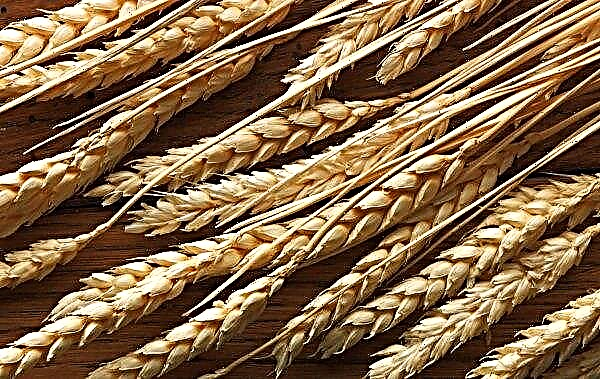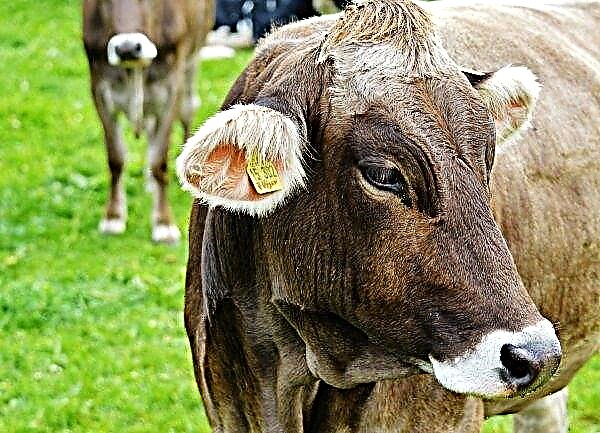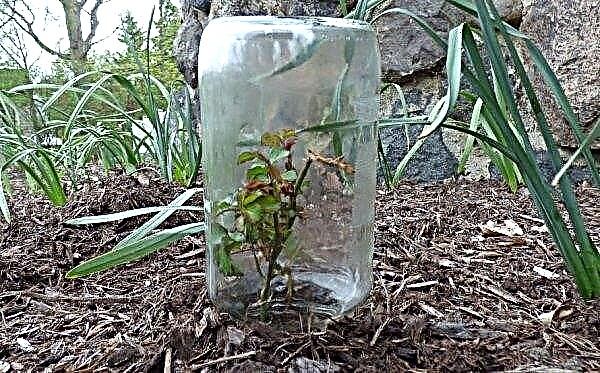Growing tomatoes requires a lot of effort and cost, as well as the availability of a summer cottage. But there are also types of tomatoes that are not too whimsical to care for and do not require extensive beds for growing. One of these varieties is Pinocchio tomato.
Grade description
Pinocchio is a dwarf plant that produces crops in the form of cherry tomatoes. Undemanding care, high productivity and compact size contribute to the high popularity of this vegetable among gardeners.
Did you know? The first cherry tomatoes were grown in 1973, in Israel.
The decorative Pinocchio tomato has such characteristics:
- refers to a determinant form;
- It is considered a dwarf tomato, about 30–35 cm high. In shape it is a small bush that is often used as an ornamental plant;
- the fruits are small, round, red. It tastes juicy, reminiscent of cherry, can be used in salads and pickles;
- the weight of one tomato is 20 g;
- tomato leaves are green, dissected, wrinkled. The shape resembles both tomato leaf and potato;
- tomatoes are early and medium ripening, it depends on the conditions of the plant;
- the first fruits can be obtained within 90-105 days after planting.

Advantages and disadvantages
Growing dwarf pinocchio tomatoes has certain advantages and disadvantages.
- Grade advantages:
- suitable for indoor and outdoor cultivation;
- possesses high tastes;
- stable and increased productivity;
- long fruiting period;
- the bush does not require garters;
- resistance to various diseases.
The disadvantage is the fact that the tie occurs once, after which the vegetable withers and loses its ability to give a new crop.
Sowing seeds for seedlings
Seedling method of cultivation of tomatoes is the most productive. Sowing seeds for seedlings is the main stage in growing tomatoes, since the yield of the bush depends on this. Seeds are planted for seedlings 50–55 days before planting at a constant place of growth. Before starting sowing, it is necessary to prepare seeds, soil and a container for tomatoes.
Important! From one tomato bush Pinocchio can be harvested from one to one and a half kilograms of fruit.
Optimal timing
The optimal time for sowing seeds for planting on seedlings depends on where the bush will be grown later. If in the garden, then the month of March or April will be acceptable. In the case of keeping the plant on the balcony or loggia, you can plant earlier, because if it suddenly gets colder, the plants can be moved to a warmer room. Those gardeners who grow Pinocchio tomatoes on the balcony sow seeds in the fall to get seedlings by the beginning of winter.
Soil mix
The soil for sowing seeds can be purchased ready-made in specialized stores of agricultural products, or prepared on their own.
The soil mixture is prepared in this way:
- First you need to take the soil from the garden, or buy it.
- Next, this land needs to be dried.
- Prepare a mixture that will include a bucket of earth, humus, peat and a glass of wood ash.
- All ingredients must be thoroughly mixed and phosphate fertilizer added, so that the root system develops well.
Important! The main rule when choosing soil for planting tomatoes is low acidity and plenty in her minerals and trace elements.
Capacity for growing
For planting Pinocchio tomatoes, disposable cups, peat tablets or containers, boxes and pots are suitable. Also, as an economy, you can use plastic bottles, having previously cut off their upper part. In the summer cottage, this plant can be planted both in the garden and in the flowerbed.
Seed preparation
To obtain good seedlings, not only the soil is important, but also correctly selected and prepared seeds for sowing. Seeds must be dry. If they are wet, there is a possibility of mold, which in the future will destroy the seedling. Defects should be absent on the seeds, since in the presence of these indicators, seedlings may not arise. In specialized stores you can buy tomato seeds that are already processed.
But if you have seeds from the garden, you can process them yourself. In order for the seeds to germinate quickly and develop well in the soil, it is necessary to treat them before planting with growth stimulants. Specialized growth stimulants are available at horticultural stores.
But natural substances remain no less effective and popular among farmers:
- A solution of aloe juice. To do this, you need to make a tincture of aloe juice and place seeds wrapped with gauze in it for an hour and a half.
- Honey tincture. One spoonful of honey is dissolved in a glass of warm water. In no case can you use boiling water, as the main active substances from honey will be destroyed. Dip the seeds in such a solution for 1.5 hours.
To disinfect seeds, perform the following procedure:
- wrap the seeds in gauze or a clean, lightweight cloth;
- prepare a weak solution of potassium permanganate;
- lower the seeds in potassium permanganate for 15-20 minutes;
- rinse the seeds in plain water;
- put the seeds in warm water for a day.
Did you know? The smallest tomato in the world in diameter reaches 2 cm, and the largest weighs one and a half kilograms.
Sowing seeds
Observing the rules of sowing seeds for seedlings, you will ensure good growth of seedlings.
The process of sowing seeds is not complicated, but it has a certain sequence:
- Prepare the soil and containers for sowing seeds.
- In each container, place one seed in a recess of up to 2 cm. Cover with a small amount of earth on top.
- Moisten the crop with water. For seedlings in the apartment, it is acceptable to pour water into the pan of the pot.
- Cover the seedlings with foil to create a suitable temperature and humidity. At the same time, several holes are made in the film so that air can circulate in the seedlings.

Seedling Care
Pinocchio tomatoes are not too demanding to care for, but keeping and growing seedlings under the right conditions increases the likelihood of a good harvest and tasty tomatoes. Because tomatoes love the sun, the pot with the bush should have enough light. They have seedlings on window sills or open balconies so that there is access to direct sunlight. In the winter season, it is necessary to additionally create lighting using lamps so that the tomatoes do not stop growing.
The temperature for tomatoes should be in the range of 23-24 ° C. The minimum allowable temperature at night is 16 ℃. Lower temperature leads to a halt in the growth of the vegetable. Tomatoes require plentiful watering. To do this, use water with a temperature of 20–25 ° C; watered in the morning, twice a week. Tomato soil should be loosened the day after watering.
Important! As soon as the first tomatoes appear on the bushes, nitrogen fertilizing is excluded.
Topping tomatoes is carried out in several stages. The first top dressing is carried out by organic substances immediately after planting in the ground. The following dressings are added once every 10-12 days, using mineral substances for this.
Seedling hardening
Growing tomato seedlings is carried out in greenhouse conditions. When a seedling is transplanted into open ground, the root system, stems and leaves of the sprout suffer from unusual conditions. In order for the period of getting used to the new environment to happen faster and cause less damage, it is necessary to harden the seedlings in advance.
Hardening is carried out the entire period of detention in greenhouses or hotbeds. Two weeks before planting in a permanent place, it is necessary to gradually reduce the temperature of the germ content to 12-14 ° C. Conducting such hardening for longer than three weeks is not recommended, since the vegetable may stop growing and fall into a dormant period. 3-5 days before transplanting, the temperature of the seedling should be the same as in the room where the tomato will be kept. To get used to this temperature, it is necessary to leave the germ in this temperature regime all night.
3-5 days before transplanting, the temperature of the seedling should be the same as in the room where the tomato will be kept. To get used to this temperature, it is necessary to leave the germ in this temperature regime all night.
Also, as a hardening, seedlings reduce watering. The volume of water remains the same, but the periods between irrigation become longer. Due to this, the soil dries in the upper part, and remains moist at the roots. This contributes to the fact that the root system of the tomato grows stronger.
It is necessary to teach tomato seedlings to the sun. In the first days after planting, direct sun rays adversely affect the seedlings and can dry them out. In order for the sprout to gradually get used to the light regime, daily increase its time in the sun. In the first weeks he is left for 15-20 minutes in the morning or after dinner. After two to three weeks of such hardening, the plant already gets used to the sun and remains under it for the whole day.
Important! It is necessary to choose no less fertile soil for the main placement of the seedling than during seedling maturation.
Planting seedlings in a permanent place
Seedlings are transferred to open ground after the cold has passed, and the threat of sudden frost disappears. The most favorable time for planting tomatoes lasts until mid-June. It is possible to transplant a seedling in open ground two months after sowing seedlings.
The procedure for planting tomatoes in open soil:
- The beds for the Pinocchio variety are dug up to a distance of 40 cm from each other.
- The depth of the hole in each bed should reach 15 cm.
- Humus is poured into the bottom of the hole. As additives, ash and superphosphate are poured.
- Next, you need to water the wells, abundantly wet them. Seedlings also moisturize before excavation.
- Carefully remove the bush from the container and transplant into the center of the hole.
- Sprinkle the seedling with earth - so as to completely cover the hole.
- After a week, watering and pruning of yellowed tomato leaves is carried out.

There are four schemes for planting tomatoes in the soil:
- Private. The most common method. Suitable for planting both in open ground and in a greenhouse. Between each row of seedlings should be from 30 to 50 cm. Tomatoes of the same row are located at a distance of 20-30 cm from each other.
- Nesting. Ideal for growing tomatoes in the open. Three bushes are formed in one nest. Bushes are planted parallel to each other at a distance of 80 cm.The distance between the seedlings along is 60 cm.
- Two-line. This landing method is also called chess. The bushes are planted in two rows, with a distance of half a meter from each other. Between the rows keep the same proportion in the distance - half a meter.
- Two-line tape. Tomato bushes are planted in two rows; the distance between them should be 60–70 cm. A distance of 25 cm is maintained between the tomatoes themselves. If necessary, 2 more rows are planted, one meter from the previous ones.
Learn how to plant tomatoes in the greenhouse.
Outdoor Care
Being in open soil, the plant is less in need of attention and care than at the seedling stage. Watering is carried out when the soil dries at the base of the plants - approximately once a week. The water temperature for irrigation is at least 22 ° C.
When a crust forms when the soil dries, it is necessary to loosen the soil. This process allows you to increase oxygen access to the root system, so that it grows more actively. The depth of cultivation is up to three centimeters. This must be done with care so as not to damage the roots of the tomato. Loosening is carried out at least once a week. Weeding the soil is necessary as weeds appear. Daylight hours for seedlings in open ground should be at least 12 hours, otherwise the plant will begin to fade. Fertilizers for Pinocchio tomatoes are selected combined. Feeding is carried out once every 10-15 days, depending on whether the tomato grows or bears fruit. If the plant has fruits, it is necessary to add potash fertilizers. Prior to this, the soil needs nitrogen enrichment.
Daylight hours for seedlings in open ground should be at least 12 hours, otherwise the plant will begin to fade. Fertilizers for Pinocchio tomatoes are selected combined. Feeding is carried out once every 10-15 days, depending on whether the tomato grows or bears fruit. If the plant has fruits, it is necessary to add potash fertilizers. Prior to this, the soil needs nitrogen enrichment.
It must be remembered that after fruiting the tomato will begin to turn yellow and wilt. This is a normal process, as the Pinocchio variety does not make a second ovary. When you begin to notice the abundance of withered leaves, you will need to replace the bush with a new one.
Features of growing on the balcony
The Pinocchio variety is specially bred for growing on the balcony, so caring for an apartment plant is quite simple. Place a pot of tomatoes on the south side of the apartment, on the windowsill or on the balcony. To make the plant feel comfortable, the Pinocchio tomato is transplanted into boxes or pots with a volume of 2-3 liters. Too large a capacity is not needed, since in a large pot of tomato all the juices will go to the growth of the rhizome, but there will be no energy left to grow the fruits.
Watering plants produce twice a week. The watering process should be carried out around the perimeter of the pot, moistening only the ground. It is important not to touch the stems and leaves with water, otherwise they will quickly turn yellow. Water is defended and watered with it when its temperature corresponds to air temperature. There should be enough water so that even in hot weather after morning watering the soil remains moist in the evening. Loosening should be carried out once a week, as for tomatoes in open soil. This procedure is also called “dry irrigation”, since when used correctly, it allows you to not water the soil for up to a week. Therefore, loosening alternate with watering.
Loosening should be carried out once a week, as for tomatoes in open soil. This procedure is also called “dry irrigation”, since when used correctly, it allows you to not water the soil for up to a week. Therefore, loosening alternate with watering.
Daytime air temperature should be up to 24 ° С, at night - up to 16 ° С. The tomato should receive adequate lighting. If the vegetable is grown in the cold season, it is necessary to additionally provide light using incandescent lamps. Fertilizers are added once every one to two weeks. Combined top dressing, including nitrogen and potassium, is suitable.
Since this plant is able to bear fruit in autumn and winter, the decorative bush with red fruits is especially happy in the cold season. The bright, juicy taste of the vegetable has gained immense popularity among many gardeners. And immunity to diseases allows even beginners to breed these tomatoes.

